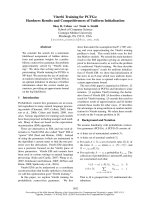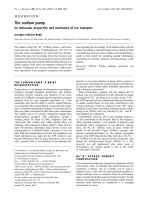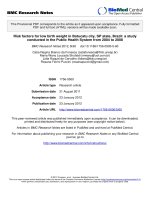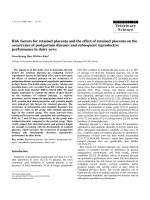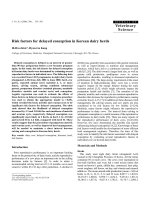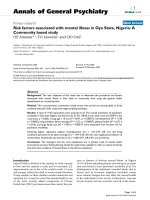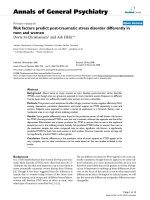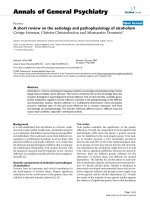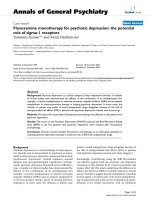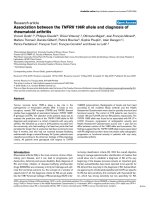Báo cáo y học: "Risk factors for multidrug resistant bacteria and optimization of empirical antibiotic therapy in postoperative peritonitis" pdf
Bạn đang xem bản rút gọn của tài liệu. Xem và tải ngay bản đầy đủ của tài liệu tại đây (283.21 KB, 8 trang )
RESEARC H Open Access
Risk factors for multidrug resistant bacteria and
optimization of empirical antibiotic therapy in
postoperative peritonitis
Pascal Augustin
1*
, Nathalie Kermarrec
1
, Claudette Muller-Serieys
2
, Sigismond Lasocki
1
, Denis Chosidow
3
,
Jean-Pierre Marmuse
3
, Nadia Valin
4
, Jean-Marie Desmonts
1
, Philippe Montravers
1
Abstract
Introduction: The main objective was to determine risk factors for presence of multidrug resistant bacteria (MDR)
in postoperative peritonitis (PP) and optimal empirical antibiotic therapy (EA) among options proposed by
Infectious Disease Society of America and the Surgical Infe ction Society guidelines.
Methods: One hundred patients hos pitalised in the intensive care unit (ICU) for PP were reviewed. Clinical and
microbiologic data, EA and its adequacy were analysed. The in vitro activities of 9 antibiotics in relation to the
cultured bacteria were assessed to propose the most adequate EA among 17 regimens in the largest number of
cases.
Results: A total of 269 bacteria was cultured in 100 patients including 41 episodes with MDR. According to logistic
regression analysis, the use of broad-spectrum antibiotic between initial intervention and reoperation was the only
significant risk factor for emergence of MDR bacteria (odds ratio (OR) = 5.1; 95% confidence interval (CI) = 1.7 - 15;
P = 0.0031). Antibiotics providing the best activity rate were imipenem/cilastatin (68%) and piperacillin/tazobactam
(53%). The best adequacy for EA was obtained by combinations of imipenem/cilastatin or piperacillin/tazobactam,
amikacin and a glycopept ide, with values reaching 99% and 94%, respectively. Imipenem/cilastin was the only
single-drug regimen providing an adequacy superior to 80% in the absence of broad spectrum antibiotic between
initial surgery and reoperation.
Conclusions: Interval antibiotic therapy is associated with the presence of MDR bacteria. Not all regimens
proposed by Infectious Disease Society of America and the Surgical Infection Society guidelines for PP can provide
an acceptable rate of adequacy. Monotherapy with imipenem/cilastin is suitable for EA only in absence of this risk
factor for MDR. For other patients, only antibiotic combinations may achieve high adequacy rates.
Introduction
Postoperative p eritonitis (PP) is a life-threatening com-
plication of abdomina l surgery with high rates of organ
failure and mortality [1]. Adequate management of
patients with PP requires supportive therapy of organ
dysfunction, source control of infection with surgery
and/or drainage, and antimicrobial therapy [2-5].
Because early and adequate antimicrobial therapy is an
important goal in these high-risk patients [6,7], it is
essential to take into account factors that mod ulate bac-
terial ecology and the susceptibility of causative organ-
isms to ensure optimal management. Increased
proportions o f multidrug resistant (MDR) bacteria have
bee n reported in this setti ng [1,8,9] and the role of pre-
vious antibiotic therapy in the emergence of these bac-
teria has been stressed [1,9]. Interestingly, few studies
have addressed the therapeutic issues and difficulties
related to the choice of empirical antibiotic therapy (EA)
raised by these MDR microorganisms.
Based on these concerns, the aim of this study was
first to identify risk factors for the presence of MDR
bacteria in PP, and then to analyse the in vitro activities
* Correspondence:
1
Department of Anesthesiology and Surgical Intensive Care Unit, Hôpital
Bichat-Claude Bernard, Université Paris VII Denis Diderot, Assistance Publique
Hôpitaux de Paris, 46 rue Henri Huchard, 75877 Paris Cedex 18, France
Augustin et al. Critical Care 2010, 14:R20
/>© 2010 Augustin et al.; licensee BioMed Central Ltd. This is an open access art icle di stributed under the terms of the Creative
Commons Attribution License ( which permits unrestricte d use, distribu tion, and
reproduction in any medium, provided the original work is properly c ited.
of some antimicrobial regimens proposed by guidelines
from the Infectious Disease Society of America (IDSA)
[2] and the Surgical I nfection Society (SIS) [3] in order
to propose antib iotic regimens providing adequate EA
in the largest number of cases according to the identi-
fied risk factors of MDR bacteria.
Materials and methods
Study population
From January 2001 to December 2004, all consecutive
adult patients with a diagnosis of PP requiring admis-
sion to a surgical intensive care unit (ICU) were pro-
spectively included in a database, and their medical
charts were retrospectively reviewed. PP was defined as
a peritoneal infection occurring after an initial abdom-
inal surgery (S0), and confirmed by macroscopic find-
ings and positive bacterial fluid culture yielding at least
one microorganism (bacteria or yeast) at reoperation. In
patients who requ ired multiple reoperations, only the
first one was considered. All types of abdominal surgery
were included except cases of complicated acute pan-
creatitis. Patients with PP with pure fungal infection
were not analysed. According to French law, because
this observational study did not modify the physicians’
laboratory or clinical practices, no informed consent was
required. The Institutional Review Board of Paris North
Hospitals, Paris 7 University,AP-HP,reviewedand
approved the study.
Susceptibility testing and empirical antimicrobial therapy
Peritoneal fluid s amples were systematically collected
during reope ration and immediately sent to the bacter-
iology laboratory . Gram staining for direct examination
and cultures were performed with identification and sus-
ceptibility testing for Gram-positive and Gram-negative
bacteria. Antibiotic susceptibility was determined by the
disk-diffusion method, according to the criteria of the
Antibiogram Comm ittee of the French Society for
Microbiology [10]. In vitro susceptibility of nine antibio-
tics (amoxicillin/clavulanic acid (amox/clav); piperacil-
lin/tazobactam (pip/taz); ceftazidime; imipenem/
cilastatin; ciprofloxacin; gentamicin; amikacin and speci-
fically metronidazole and vancomycin (for anaerobes
and Gram-positive cocci)) was recorded for all bacteria.
Results were expressed as proportions of susceptible
bacteria for each antibiotic. Parenteral EA was systema-
tically started at the time of reoperation according to
the recommendations of our institutional protocol for
PP. This protocol is based on treatment with a broad-
spectrum beta-lactamin pip/taz or imip enem. Imipene m
is selected for patients with severe peritonitis and/or
previous antimicrobial therapy. The use of amikacin for
spectrum broadening and synergistic combination is
optional. The adjunction of vancomycin is considered in
cases of prolonged hospital stay or methicillin-resistant
staphylococcus or amoxicillin-resistant enterococcus
car riage. Adequacy of E A was assessed according to the
regimen used and the number of antibiotics in the case
of combination therapy. Empirical antimicrobial therapy
was considered adequate i f, according to the susceptibil-
ity testing, all bacteria isolated were susceptible to at
least one of the drugs administered. The antibiotic selec-
tion was considered to b e adequate or inadequate
strictly on the basis of the culture results obtained and
did not reflect the authors’ subjective assessment of
appropriateness of care.
Optimization of empirical antibiotic therapy
Analysis of antibiotic regimens classified as monother-
apy or combination therapy (two-, three- and four-drug
regimens) allowed the assessment of 17 potential regi-
mens in order to determine suitable treatments provid-
ing adequate EA in the largest number of cases. This
analysis was performed according to the presence or
absence of MDR bacteria, and then according to the
presence or absence of a risk factor for MDR strains
found in our analysis. As the purpose of this study was
to focus on antimicrobial therapy, fungi were not
included in the definition of adequacy.
Definitions
MDR bacteria were defined as: methicillin-resistant Sta-
phylococcus aureus and coagulase-negative staphylococci
(CNS); Enterobacteriaceae producing an extended-spec-
trum beta-lactamase or producing a cephalosporinase: and
non-fermenting Gram-negative aerobes r esistant to pip/
taz, ceftazidime, or imipenem/cilas tatin, or producing an
extended-spectrum beta-lactamase (Pseudomonas aerugi-
nosa and Acinetobacter baumanii). In line with the IDSA
and SIS guidelines considering broad-spectrum agents
active against P. aeruginosa, and methicillin-susceptible
and amoxicillin-susceptible Enterococcus, we arbitrarily
defined pip/taz, imipenem/cilastatin, and fluoroquinolones
as broad-spectrum antibiotics. Interval antibiotics (IA)
were defined as antimicrobial agents administered between
S0 and reoperation, at during at least 24 hours and started
at least 24 hours before reoperation. The us e of all-types
of IA and broad-spectrum IA during this period was
recorded in every case and constituted new variables f or
the analysis. The reason for their prescription was
recorded.
Data collected
The pati ents’ medical charts were reviewed and the fol-
lowing information was collected: age; gender; severity
of the underlying medical condition [11]; presence of
chronic diseases (such as malignancy; diabetes mellitus;
steroid or immunosuppressive therapy for inflammatory
Augustin et al. Critical Care 2010, 14:R20
/>Page 2 of 8
bowel disease); previous hospitalization or antibiotic
therapy within three months before S0; characteristics of
S0, if performed in another institution, its type, route
and wound class [12 ]; and use of IA . Parameters col-
lected within the first 48 hours after ICU admission
were: t emperature; acute physiology and chronic health
evaluation (APACHE) II score [13]; Sequential Or gan
Failure Assessment (SOFA) score [14]; organ failures
assessed following Knauss definitions [15]; etiology and
primary site (above or b elow transverse mesocolon) of
the infection responsible for PP and time to reoperation;
identification of pathogens in peritoneal fluid; and
results of antimicrobial susceptibility tests.
Outcome
Patient outcome was recorded as the number of reo-
perations, duration of mechanical ventilation, ICU
length of stay, and ICU mortality. The prognosis was
assessed by taking into account the presence of MDR
organisms and the adequacy of EA.
Statistical analysis
Results are expressed as mean ± standard deviation, and
as percentages for categorical variables. All analyses
were performed using the Statview software package
(version 5.0; SAS institute Inc, Cary, NC, USA). As the
primary objective of the study was to determine risk fac-
tors and outcome of PP patients with MDR bacteria, the
group of patients with MDR bacteria (called MDR
group) was compared with the group of patients with
‘other’ bacteria (called other group). Secondly, the
impact of broad-spectrum IA on suscepti bility of micro-
organisms collected from peritoneal samples was ana-
lyzed. Univariate analysis was performed using Student’s
t - test or Wilcoxon’sranksumtest,asappropriatefor
continuous variables, and the Chi squared or Fisher ’ s
exact test, as appropriate, for categorical variables. All
variables with a P value less than 0.10 in the univariate
analysis were entered into a multivariate logistic regres-
sion analysis. Odds ratio (OR) and 95% confidence
intervals (CI) were calculated. S tatistical significance was
defined as P < 0.05.
Results
Demographics on admission to ICU
During the study period, 107 patients with PP were
admitted to our ICU. Seven patients were excluded
because only fungi were found on culture. Epidemiol ogic
characteristics, clinical status of the 100 patients on
admission and clinical findings at the time of reoperation
are shown in Tables 1 and 2. Initial surgery was digestive
in 80 cases, hepatobiliary in 5 cases, urologic in 7, mixed
urologic/digestive in 3 cases, and gynaecologic in 8 cases.
In this study population, the presence of MDR bacteria
was reported in 41 PP patients and 59 PP patients were
free of MDR strains. According to univariate analysis,
factors associated with the presence of MDR bacteria in
peritoneal samples at the time of PP were emergent
initial surgery, contaminated or infected initial surgery,
prior antibiotic therapy before S0, IA and broad-spec-
trum IA. When these variables were entered into a logis-
tic regression model, the use of broad-spectrum IA was
the only significant risk factor for emergence of MDR
bacteria (OR = 5.1; 95% CI = 1.7 to 15; P = 0.0031).
Susceptibility testing and interval antimicrobial therapy
A total of 269 bacteria were cultured from peritoneal
fluid (Table 3). Twenty five yeasts were isolated including
Table 1 Demographic characteristics at initial surgery S0, and interval antibiotic therapy in the 100 patients with PP
Variable Patients with MDR bacteria
(n = 41)
Patients with other bacteria
(n = 59)
P
Age (year), mean ± SD 63 ± 17 60 ± 16 0.37
Gender, male, n (%) 24 (59) 32 (54) 0.83
Severity of underlying disease
Fatal (within 5 years), n (%) 16 (39) 21 (36) 0.92
Malignancy, n (%) 17 (41) 22 (37) 0.86
Diabetes mellitus, n (%) 7 (17) 11 (19) 0.91
Steroids or immunosuppressive therapy, n (%) 15 (37) 27 (46) 0.36
Initial surgery
In emergency, n (%) 20 (49) 15 (25) 0.01
Contaminated or infected wound class, n (%) 25 (61) 19 (32) 0.016
Prior hospitalization (within 3 months prior S0), n (%) 24 (59) 29 (49) 0.24
Prior antibiotic therapy (within 3 months, prior S0), n
(%)
18 (44) 13 (22) 0.02
Interval antibiotics, n (%) 33 (80) 35 (59) 0.026
Broad-spectrum interval antibiotics, n (%) 25 (61) 11 (19) 0.0001
MDR, multidrug resistant; PP, postoperative peritonitis; SD, standard deviation; S0, initial abdominal surgery.
Augustin et al. Critical Care 2010, 14:R20
/>Page 3 of 8
Candida albicans (n = 12), Candida glabrata (n = 7) and
Candida tropicalis (n = 4). Most patients (n = 68)
received all-types of IA, and 35 of them received broad-
spectrum IA. The main reasons for IA were contami-
nated or septic initial surgery, suspicion or occurrence of
PP (n = 26), and new focus of infection (n = 21) including
12 cases of pneumonia. The distribution of bacteria
according to the use of broad-spectrum IA therapy is
presented in Table 4. The number of bacteria cultured
from peritoneal fluid, was not different when broad-spec-
trum IA therapy had been administered (2.5 ± 1.7 vs 2.8 ±
2.1, P = 0.22). In these patients, we observed that cultures
of peritoneal fluid samples exhibited a trend toward
increased proportio ns of monomicrobial samples (20% vs
8% in patients without broad spectrum IA therapy, P =
0.18), with a higher number of MDR microorganisms,
Table 2 Characteristics and clinical findings at reoperation in the 100 patients with PP
Variable Patients with MDR
bacteria (n = 41)
Patients with other
bacteria (n = 59)
P
APACHE II, mean ± SD 21 ± 7 21 ± 7 0.90
SOFA, mean ± SD 7 ± 4 7 ± 4 0.63
≥ 1 organ failures, n (%) 32 (78) 48 (81) 0.68
Vasopressor support, n (%) 26 (63) 41 (69) 0.38
Time to reoperation (days), mean ± SD 13 ± 16 10 ± 11 0.55
Mechanisms of PP
Anastomotic leakage, n (%) 14 (34) 20 (34) 0.98
Perforation, n (%) 9 (22) 21 (36) 0.14
Miscellaneous, n (%) 8 (20) 10 (17) 0.98
Unknown cause, n (%) 10 (24) 8 (14) 0.27
Source of PP
Lower intestinal tract, n (%) 16 (39) 32 (54) 0.67
APACHE, acute physiology and chronic health evaluation; MDR, multidrug resistant; PP, postoperative peritonitis; SD, standard deviation; SOFA, Sequential Organ
Failure Assessment.
Table 3 Bacteria isolated from peritoneal fluid in 100
episodes of postoperative peritonitis
Microorganisms Number of
strains
n (%)
Monomicrobial
infection
Gram-positive bacteria 108 (40)
Enterococci 50 (19)
E. faecium 11 (4)
Other 39 (14) 1
Streptococci 30 (11)
Staphylococci 28 (10)
S. aureus 7 (3)
Coagulase-negative
staphylococci
21 (8) 3
Gram-negative bacteria 119 (44)
Enterobacteriaceae 101 (37)
Escherichia coli 49 (18) 4
Enterobacter species 22 (8) 1
Klebsiella species 13 (5)
Morganella morganii 7 (3) 1
Proteus species 5 (2)
Citrobacter species 5 (2)
Pseudomonas aeruginosa 16 (6) 1
Acinetobacter baumannii 2 (1)
Miscellaneous 6 (2) 1
Anaerobes 36 (13)
Bacteroides species 20 (7)
Total bacteria 269 (100) 12
Table 4 Numbers and percentages of bacteria
responsible for PP according to the use of
broad-spectrum IA
Microorganisms Patients without
broad-spectrum IA
(n = 65)
Patients with
broad-spectrum
IA (n = 35)
Multidrug resistant bacteria,
n(%)
24 (13) 41 (48) *
Enterobacteriaceae, n(%) 9 (5) 16 (19) *
Pseudomonas aeruginosa,
n(%)
3 (2) 5 (6)
Acinetobacter baumannii,
n(%)
1 (1) 1 (1)
Enterococci, n(%) 4 (2) 3 (3)
Methicillin-resistant
S. aureus, n(%)
4 (2) 3 (3)
Methicillin-resistant CNS,
n(%)
3 (2) 13 (15) *
Other bacteria, n(%) 160 (87) 44 (52)
Enterobacteriaceae, n(%) 69 (37) 11 (13) *
Pseudomonas aeruginosa,
n(%)
2 (1) 6 (7)
Enterococci, n(%) 31 (17) 12 (14)
Streptococci, n(%) 27 (15) 5 (6)
Staphylococci, n(%) 5 (3) 0
Other pathogens, n(%) 26 (14) 10 (12)
Total number of bacteria 184 (100) 85 (100) *
CNS, coagulase negative staphylococci; IA, interval antibiotic therapy; PP,
postoperative peritonitis; * P < 0.05 vs group without broad-spectrum IA.
Augustin et al. Critical Care 2010, 14:R20
/>Page 4 of 8
mainly due to resistant Enterobacteriaceae and me thicillin-
resistan t CNS (P < 0.05 for both cases). All-types of IA
were associated with a decreased number of bacteria (2.4
±1.5vs 3.4 ± 2.4, P = 0.001) and PP was more often
monomicrobial PP (28% vs 3%, P = 0.001).
Proportions of susceptible Gram-negative and Gram-
positive strains have been evaluated. Among the various
antibiotics tested, imipenem/cilastatin and amikacin
were the most consistently active against aerobic Gram-
negative bacteria in all patients, whereas the efficacy of
pip/taz (87% vs 40%, P < 0.0001) and ceftazidime (87%
vs 60%, P = 0.009) was markedly reduced in patients
with broad-spectrum IA therapy. Vancomycin was the
age nt most frequent ly active against Gram-positi ve bac-
teria in all patients, e xcept in one case of a naturally
resistant Enterococcus casseliflavus strain. Following
broad-spectru m IA therapy, staphylococci were resistant
to beta-lactams and ciprofloxacin. The 36 cultured anae-
robes had susceptibility rates of 87%, 93%, 93% and
100% toward amox/clav, pip/taz, metronidazole, and
imipenem/cilastatin, respe ctiv ely. Among the 20 Bacter-
oides strains, four were resistant to amox/clav, two to
pip/taz and one to metronidazole.
Empirical antimicrobial therapy
We analysed EA prescribed at the time of reoperation in
the 100 PP patients: monotherapy in 53 cases (45 pip/
taz; 5 imipenem), double-drug combinations in 32 cases
(13 based on pip/taz; 10 based on imipenem), and tri-
ple-drug combinations in 13 cases (4 based on pip/taz; 4
based on imipenem). Adequacy rat es were 64%, 66%,
and 62%, for monotherapies, double-drug combinations,
and triple-drug combinations, respectively.
Pip/taz (n = 66) and imipenem/cilastatin (n = 23) were
the main agents prescribed. Imipenem/cilastatin was
more frequently administered than pip/taz in seriously
ill p atients (SOFA score 6 ± 4 vs 9±3,P = 0.005), and
in the case of prior broad-spectrum IA therapy between
S0 and reoperation (87% for imipenem vs 65% for pip/
taz; P = 0.04). A higher SOFA score was also associated
with prescriptions of combinations rather than mono-
therapy (6 ± 4 for monotherapy vs 8 ± 4 for combina-
tion; p = 0.03). Three allergic patients received triple-
drug combinations without beta-lactams. One patient
with previous colonization by a multiresistant str ain of
P. aeruginosa received a four-drug combination (imipe-
nem/cilastatin + vancomycin + aminoglyc osides + colis-
tin). One patient received antifungal therapy only
because of previous fungal colonization and negative
direct examination of peritoneal fluid.
Adequate EA was achieved in 64% of cases. Adequacy
of EA decreased significantly in patients with MDR bac-
teria, as compared with patients with ‘other bacteria’
(39% vs 81%, P < 0.0001).
Optimization of empirical antibiotic therapy
Evaluation of the a dequacy rates of 17 theo retical regi-
mens in the 100 episodes of PP according to the pre-
sence or absence of MDR bacteria, and according to the
prescription of a broad-spectrumIAareshowninFig-
ures 1 and 2, respectively. Only combination regimens
including vancomycin achieved empirical therapy ade-
quacy rates higher than 80%. Regimens based on imipe-
nem/cilastatin obtained the highest adequacy rate. In
patients with broad-spectrum IA, monotherapy with
imipenem/cilastatin provided only poor adequacy rates,
but was suitable for patients without broad-spectrum
IA. Monotherapy with pip/taz gave poor results even in
patients without broad-spectrum IA.
Outcome
Forty-four patients had a reoperation after R1 (first
repoperat ion at ICU a dmission) because of persistent
peritonitis. ICU mortality rate was 31%. Mortality did
not differ between patients with adequate EA and others
(30% vs 31%, P = 0.9), and between patients with PP
caused by MDR bacteria and other bacteria (29% for
MDR group vs 35% for others, P =0.69).Themean
duration of antibiotic therapy (10 ± 4 days vs 12 ± 6
days, P = 0.07), mechanical ventilation (10 ± 9 d ays vs
11 ± 16 days, P = 0.6), length of ICU stay (16 ± 11 days
vs 20 ± 19 days, P = 0.2), as well as the number of reo-
perations (0.8 ± 1.4 vs 0.8 ± 1, P = 0.9) w ere similar i n
patients with adequate EA and other patients, respec-
tively. No outcome difference was observed between
patients with MDR bacteria and patients with other
microorganisms.
Discussion
In this single-center study, broad-spectrum IA pre-
scribed between initial surgery and reoperation for PP
was associated with the emergence of MDR bacteria in
peritoneal samples, mostly Enterobact eriac eae and CNS.
Only combination EA adequately targeted all bacteria.
Guidelines for antibiotic therapy for severe intra-abdom-
inal infections issued by the IDSA [2] and SIS [3] provide
a list of regimens suitable for the treatment of peritonitis,
but these recommendations do not specifically address the
case of PP. These statements indicate that local nosoco-
mial resistance patterns should guide EA.
The role of antibiotic therapy in the modification of
bowel flora and in the selection of MDR bacteria is well
known [16,17], but has been rarely assessed in P P [1,9].
In this setting, IA use reported in 62 to 80% of PP
patients [1,8,9] could play an important role i n the
selection of MDR strains. To our knowledge, a signifi-
cant link between broad-spectrum IA and emergence of
MDR Enterobacteri aceae and CNS has not been pre-
viously described in patients with PP [1,8,9].
Augustin et al. Critical Care 2010, 14:R20
/>Page 5 of 8
The bacteriologic profiles found in our population are
similar to tho se previously described in PP [1,8,9,18-20].
Interestingly, the proportions of MDR organisms in our
institution appear to have remained fairly stable over
the past 10 ye ars [8] and are situated in the same range
as those observed in another French institution [9]. The
proportion of enterococci is situated within the usual
range in our population [1,8,9,18] without vancomycin-
resistant strains [9,20]. A high prevalence of CNS was
observed, as in previous reports [1,8,9,18,21,22]. The
majority of studies on PP did not identify the type of
staphylococci (CNS or S. aureus). We may hypothesise
that some authors do not record CNS as a pathogen.
Current knowledge does not allow differentiation of
microorganisms with a clinical relevance from suspected
‘non-pathogenic’ strains. Enterococci and CNS share a
number of similarities, such as presence at l ow concen-
tration in peritoneal fluid, low pathogenicity and pre-
sence as commensals in the bowel flora. They are also
considered to be typical representatives o f tertiary peri-
tonitis in association with Pseudomonas and Candida
[3,4]. Although there is a general agreement to target
enterococci in PP antibiotic therapy, there is no thera-
peutic statement regarding CNS [2,3]. We deliberately
97
29
95 95 95
80
98
97
98 98
97
83
98
61
73
41
51
93
29
41
37
88
27
17
88
32
15
29
78
100
95
100
97
100
0
10
20
30
40
50
60
70
80
90
100
Pip/
t
az
I
mi
pe
ne
m
Cip
+
met
P
i
p/
taz +
ge
n
ta
mi
ci
n
Pip/t
a
z
+
ami
k
aci
n
P
i
p/
taz +
cip
P
i
p/
taz +
va
n
Imip
e
nem
+
gentamicin
I
mi
pe
ne
m
+
a
mika
ci
n
Imipenem
+
ci
p
i
mi
pen
em
+
va
n
P
i
p/
taz +
amikaci
n
+
van
Pip/taz + cip +
van
I
mi
pe
nem
+
ami
ka
ci
n +
v
an
Imipenem + cip +
van
C
i
p +
met
+
van
Cip + met + ami
kaci
n + van
%
PP with multiresistant
bacteria
without multiresistant bacteria
Figure 1 Adequacy rates of 17 theoretical antibiotic regimens according to the presence or absence of multidrug resistant bacteria.
cip, ciprofloxacin; met, metronidazole; pip/taz, piperacillin/tazobactam; PP, postoperative peritonitis.
69
83
25
82
83
80
83
88
86
83
100
97
95
100 100
89
95
83
66
91
98
74
89
86
46
51
46
40
20
43
46
30
40
54
0
10
20
30
40
50
60
70
80
90
100
P
ip/taz
Imi
penem
Ci
p
+ m
et
P
i
p/
t
az
+
gent
amicin
Pip/taz + am
i
kacin
Pip/
taz
+
cip
Pip/
taz
+
van
Im
i
penem
+
gentam
i
ci
n
Imi
penem
+
amikaci
n
Imi
penem
+
ci
p
I
mipenem +
van
P
ip/taz
+
ami
kac
i
n +
van
P
ip/taz
+
c
ip +
van
Im
i
penem
+
a
mikacin
+
van
I
m
i
penem
+
c
i
p
+
van
Ci
p
+
m
et
+van
C
ip
+
m
et
+
am
i
kacin
+
van
%
Broad spectrum IA
without broad spectrum IA
Figure 2 Adequacy rates of 17 theoretical antibiotic regimens according to the pr esence or absence of broad-spectrum IA.cip,
ciprofloxacin; met, metronidazole; IA, interval antibiotics; pip/taz, piperacillin/tazobactam.
Augustin et al. Critical Care 2010, 14:R20
/>Page 6 of 8
chose to ta rget these microorganisms in the EA of PP
patients. T his somewhat crude att itude therefore corre-
sponds to the lowest common denominator for clini-
cians with the assurance of targeting all pathogenic
strains.
Recent guidelines emphasize the importance of early
EA targeting all microorganisms followed by rapid de-
escalation after microbiologic identification of pathogens
and susceptibility testing [2,3,6,7]. In line with IDSA and
SIS g uidelines [2,3], our local recommendations for EA
were mainly based on a broad-spectr um monotherapy.
In our population, not all regimens proposed for EA are
suitable for all patients. Furthermore, our data suggest
that none of the monotherapies proposed would provide
a high rate of adequacy [2-4]. Consequently, we assume
that patients with ris k factors for MDR strains should
receive antibiotic combinations, whereas broad-spectrum
monotherapy should be restricted to those without
broad-spectru m IA. Interestingly, the spectrum of activ-
ity of pip/taz does not seem to be sufficient even in the
subgroup of patients with no risk factors for MDR bac-
teria. This result is not consistent with a multicenter
trial that reported similar results for pip/taz alone or
combined with aminoglycosides [19]. However, this
study was performed 10 years ago and may no longer
reflect current concerns [20,23]. Our results suggest that
routine identification and susceptibility testing of perito-
neal samples remain mandatory for subsequent de-esca-
lation antibiotic therapy, to report prevalence of
resistance and to detect trends over time.
Inadequate antimicrobial therapy has been shown to
prolong hospitalisation and is associated with increased
clinical failures and higher mortality rates [7,8,24,25].
This link between inadequate EA and outcome was not
observed in this study, as in several other recent studies
of nosocomial peritoneal infections [1,9,18,20,26]. This
apparent contradiction could be attributed to the def ini-
tion of inadequacy, which takes into account all of the
strains isolated, including enterococci or CNS whose
pathogenicity remains a subject of debate. We may also
hypothesise that our previous results were wrong or
obtained by chance [8]. A more plausible explanation
could be the changing trends in patients’ characteristics,
improvement of surgical techniques and intensive care
management over the years. The weight of antibiotic
therapy in patient outcome may have decreased. Indeed,
the more important part of management of peritonitis
remains surgery to control the source of infection and
decrease bacterial load. Despite the uncertain links
between prognosis and inadequacy of EA, we assume
that an EA targeting all pathogens is a reasonable goal
to be achieved in line with current recommendations
[6,7]. However, the benefits of broad-spectrum combina-
tions must b e balanced with their potential drawbacks,
such as emergence of resistance, high costs, and toxic
effects.
This study may present a number of limitations. Even if
our results are similar to observations reported at the
same period in tw o prospective French studies, a single-
center study [9] and a susceptibility survey performed in
25 French institutions [20], our results obt ained in a sin-
gle-center study cannot provide any definitive conclusions
for other institutions. This point is of particular value for
other countries. In fact, very few studies have been con-
ducted outside of France and reported approximately the
same bacteriologic profiles [1], but data on susceptibility
patterns are scarce and weak [27]. However, this study
emphasizes the need to evaluate bacteriologic profiles in
each institution. The definition of adequacy is based purely
on microbiologic criteria and aprioriassumptions and
does not take yeasts into account. Agents other than those
reported here could have been chosen, but these drugs
were not routinely used and were not systematically tested
in our microbiology laboratory.
Conclusions
Our data suggest that identification of risk factors for
MDR strains could help to improve the adequacy of early
EA in PP patients. In our population, patients receiving
IA therapy seem to be at risk of emergence of MDR
strains and at high risk of inadequate EA. In presence of
this risk factor, only combination therapies provided a
high probability of adequate EA. Such a policy of optimi-
sation of EA should be discussed locally based on analysis
of resistance patterns of PP, so as to identify among
options pro posed by guidelines, regimens providing
acceptable adequacy rates. Longitudinal evaluation is also
necessary to follow the evolution of resistance patterns.
Key messages
• The high rate of MDR bacteria in PP is confirmed.
• Broad-spectrum IA between initial surgery and
reoperation for PP is a risk factor for emergence of
MDR bacteria.
• Not all antibiotic regimens proposed by IDSA or
SIS for PP can provide high rate of adequacy.
• Pip/taz alone may be inadequate in a large number
of cases even in absence of the risk factor for MDR.
• In presence of the risk factor for MDR, only com-
bination regimens can provide high rate of adequacy.
Abbreviations
amox/clav: amoxicillin/clavulanic acid; APACHE: acute physiology and
chronic health evaluation; CI: confidence intervals; CNS: coagulase-negative
staphylococci; EA: empirical antibiotic therapy; IA: interval antibiotics; ICU:
intensive care unit; IDSA: Infectious Disease Society of America; MDR:
multidrug resistant; OR: odd ratio; pip/taz: piperacillin/tazobactam; PP:
postoperative peritonitis; S0: initial abdominal surgery; SIS: Surgical Infection
Society; SOFA: Sequential Organ Failure Assessment.
Augustin et al. Critical Care 2010, 14:R20
/>Page 7 of 8
Author details
1
Department of Anesthesiology and Surgical Intensive Care Unit, Hôpital
Bichat-Claude Bernard, Université Paris VII Denis Diderot, Assistance Publique
Hôpitaux de Paris, 46 rue Henri Huchard, 75877 Paris Cedex 18, France.
2
Department of Microbiology, Hôpital Bichat-Claude Bernard, Université Paris
VII Denis Diderot, Assistance Publique Hôpitaux de Paris, 46 rue Henri
Huchard, 75877 Paris Cedex 18, France.
3
Department of General Surgery,
Hôpital Bichat-Claude Bernard, Université Paris VII Denis Diderot, Ass istance
Publique Hôpitaux de Paris, 46 rue Henri Huchard, 75877 Paris Cedex 18,
France.
4
Department of Infectious Diseases, Hôpital Saint-Antoine, Université
Paris VI, Assistance Publique Hôpitaux de Paris, 184 rue du Faubourg Saint-
Antoine, 75571 Paris Cedex 12, France.
Authors’ contributions
PA drafted the manuscript and helped in the data collection. NK drafted the
manuscript, helped in the data collection, and in the study conception. CMS
had a contribution for bacteriologic data and manuscript revision . SL had a
contribution in the manuscript preparation and data collection. DC had a
contribution in the manuscript preparation and data collection. JPM had a
contribution in the manuscript preparation and data collection. NV
contributed in the manuscript and statistical revision. JMD has been
involved in the conception of the study. PM conceived the design and
coordination and helped to draft the manuscript. All authors read and
approved the final manuscript.
Competing interests
The authors declare that they have no competing interests.
Received: 15 October 2009 Revised: 6 January 2010
Accepted: 15 February 2010 Published: 15 February 2010
References
1. Roehrborn A, Thomas L, Potreck O, Ebener C, Ohmann C, Goretzki PE,
Röher HD: The microbiology of postoperative peritonitis. Clin Infect Dis
2001, 33:1513-1519.
2. Solomkin JS, Mazuski JE, Baron EJ, Sawyer RG, Nathens AB, DiPiro JT,
Buchman T, Dellinger EP, Jernigan J, Gorbach S, Chow AW, Bartlett J,
Infectious Diseases Society of America: Guidelines for the selection of
anti-infective agents for complicated intra-abdominal infections. Clin
Infect Dis 2003, 37:997-1005.
3. Mazuski JE, Sawyer RG, Nathens AB, DiPiro JT, Schein M, Kudsk KA,
Yowler C, Therapeutic Agents Committee of the Surgical Infections Society:
The Surgical Infection Society guidelines on antimicrobial therapy for
intra-abdominal infections: an executive summary. Surg Infect (Larchmt)
2002, 3:161-173.
4. Marshall JC, Innes M: Intensive care unit management of intra-abdominal
infection. Crit Care Med 2003, 31:2228-2237.
5. Marshall JC, Maier RV, Jimenez M, Dellinger EP: Source control in the
management of severe sepsis and septic shock: An evidence-based
review. Crit Care Med 2004, 32:S513-S526.
6. Dellinger RP, Levy MM, Carlet JM, Bion J, Parker MM, Jaeschke R, Reinhart K,
Angus DC, Brun-Buisson C, Beale R, Calandra T, Dhainaut JF, Gerlach H,
Harvey M, Marini JJ, Marshall J, Ranieri M, Ramsay G, Sevransky J,
Thompson BT, Townsend S, Vender JS, Zimmerman JL, Vincent JL:
Surviving Sepsis Campaign: international guidelines for management of
severe sepsis and septic shock: 2008. Crit Care Med 2008, 36:296-327.
7. Kumar A, Roberts D, Wood KE, Light B, Parrillo JE, Sharma S, Suppes R,
Feinstein D, Zanotti S, Taiberg L, Gurka D, Kumar A, Cheang M: Duration of
hypotension before initiation of effective antimicrobial therapy is the
critical determinant of survival in human septic shock. Crit Care Med
2006, 34:1589-1596.
8. Montravers P, Gauzit R, Muller C, Marmuse JP, Fichelle A, Desmonts JM:
Emergence of antibiotic-resistant bacteria in cases of peritonitis after
intraabdominal surgery affects the efficacy of empirical antimicrobial
therapy. Clin Infect Dis 1996, 23:486-494.
9. Seguin P, Laviolle B, Chanavaz C, Donnio PY, Gautier-Lerestif AL,
Campion JP, Mallédant Y: Factors associated with multidrug-resistant
bacteria in secondary peritonitis: impact on antibiotic therapy. Clin
Microbiol Infect 2006, 12:980-985.
10. Members of the SFM Antibiogram Comitee: Comité de l’Antibiogramme
de la Société Française de Microbiologie report 2003. Int J Antimicrob
Agents 2003, 21:364-391.
11. McCabe WR JG: Gram negative bacteremia. Arch Intern Med 1962,
110:847-864.
12. Polk HC Jr, Lopez-Mayor JF: Postoperative wound infection: a prospective
study of determinant factors and prevention. Surgery 1969, 66:97-103.
13. Knaus WA, Draper EA, Wagner DP, Zimmerman JE: APACHE II: a severity of
disease classification system. Crit Care Med 1985, 13:818-829.
14. Vincent JL, Moreno R, Takala J, Willatts S, De Mendonça A, Bruining H,
Reinhart CK, Suter PM, Thijs LG:
The SOFA (Sepsis-related Organ Failure
Assessment) score to describe organ dysfunction/failure. On behalf of
the Working Group on Sepsis-Related Problems of the European Society
of Intensive Care Medicine. Intensive Care Med 1996, 22:707-710.
15. Knaus WA, Draper EA, Wagner DP, Zimmerman JE: Prognosis in acute
organ-system failure. Ann Surg 1985, 202:685-693.
16. DiNubile MJ, Chow JW, Satishchandran V, Polis A, Motyl MR, Abramson MA,
Teppler H: Acquisition of resistant bowel flora during a double-blind
randomized clinical trial of ertapenem versus piperacillin-tazobactam
therapy for intraabdominal infections. Antimicrob Agents Chemother 2005,
49:3217-3221.
17. Georges B, Conil JM, Dubouix A, Archambaud M, Bonnet E, Saivin S,
Lauwers-Cancès V, Cristini C, Cougot P, Decun JF, Mathe O, Chabanon G,
Marty N, Seguin T, Houin G: Risk of emergence of Pseudomonas
aeruginosa resistance to beta-lactam antibiotics in intensive care units.
Crit Care Med 2006, 34:1636-1641.
18. Sotto A, Lefrant JY, Fabbro-Peray P, Muller L, Tafuri J, Navarro F,
Prudhomme M, De La Coussaye JE: Evaluation of antimicrobial therapy
management of 120 consecutive patients with secondary peritonitis. J
Antimicrob Chemother 2002, 50:569-576.
19. Dupont H, Carbon C, Carlet J: Monotherapy with a broad-spectrum beta-
lactam is as effective as its combination with an aminoglycoside in
treatment of severe generalized peritonitis: a multicenter randomized
controlled trial. The Severe Generalized Peritonitis Study Group.
Antimicrob Agents Chemother 2000, 44:2028-2033.
20. Montravers P, Lepape A, Dubreuil L, Gauzit R, Pean Y, Benchimol D,
Dupont H: Clinical and microbiological profile of community-acquired
and nosocomial intra-abdominal infections: results of the French
prospective EBIIA study. J Antimicrob Chemother 2009, 63:785-794.
21. Pieracci FM, Barie PS: Intra-abdominal infections. Curr Opin Crit Care 2007,
13:440-449.
22. Solomkin JS: Antibiotic resistance in postoperative infections. Crit Care
Med 2001, 29:N97-N99.
23. Rossi F, Baquero F, Hsueh PR, Paterson DL, Bochicchio GV, Snyder TA,
Satishchandran V, McCarroll K, DiNubile MJ, Chow JW: In vitro
susceptibilities of aerobic and facultatively anaerobic Gram-negative
bacilli isolated from patients with intra-abdominal infections worldwide:
2004 results from SMART (Study for Monitoring Antimicrobial Resistance
Trends). J Antimicrob Chemother 2006, 58:205-210.
24. Krobot K, Yin D, Zhang Q, Sen S, Altendorf-Hofmann A, Scheele J, Sendt W:
Effect of inappropriate initial empiric antibiotic therapy on outcome of
patients with community-acquired intra-abdominal infections requiring
surgery. Eur J Clin Microbiol Infect Dis 2004, 23:682-687.
25. Koperna T, Schulz F: Prognosis and treatment of peritonitis. Do we need
new scoring system?. Arch Surg 1996, 131:180-186.
26. Montravers P, Dupont H, Gauzit R, Veber B, Auboyer C, Blin P, Hennequin C,
Martin C: Candida as a risk factor for mortality in peritonitis. Crit Care
Med 2006, 34:646-652.
27. Kusachi S, Sumiyama Y, Nagao J, Arima Y, Yoshida Y, Tanaka H, Nakamura Y,
Saida Y, Watanabe M, Sato J:
Drug susceptibility of isolates from severe
postoperative intraperitoneal infections causing multiple organ failure.
Surg Today 2005, 35:126-130.
doi:10.1186/cc8877
Cite this article as: Augustin et al .: Risk factors for multidrug resistant
bacteria and optimization of empirical antibiotic therapy in
postoperative peritonitis. Critical Care 2010 14:R20.
Augustin et al. Critical Care 2010, 14:R20
/>Page 8 of 8
